Global Patterns in Construction and Demolition Waste (C&DW) Research: A Bibliometric Analysis Using VOSviewer
Abstract
1. Introduction
2. Context for C&DW Research
2.1. Planetary Boundaries and C&DW
2.2. Material Flows: Extraction, Construction, Waste
3. Context of Bibliometric Research on C&DW
3.1. Global Increases in Research
3.2. Existing Previous C&DW Bibliometric Reviews
4. Methodology
4.1. Search Strategies
4.2. Visualisations
4.3. Opportunities and Limitations
5. Results and Findings
5.1. Search 1: C&DW Management
5.2. Search 2: Green Evaluations
5.3. Search 3: Reuse and Recycling
5.4. Search 4: Reusing Buildings
5.5. Search 5: Circularity
5.6. Search 6: Waste Minimisation of C&DW
5.7. Search 7: Waste Minimization Generally
6. Discussion
6.1. Overall Patterns in Findings
6.2. Patterns in Themes
7. Conclusions
Supplementary Materials
Author Contributions
Funding
Institutional Review Board Statement
Informed Consent Statement
Data Availability Statement
Conflicts of Interest
References
- Ferdous, W.; Manalo, A.; Siddique, R.; Mendis, P.; Zhuge, Y.; Wong, H.S.; Lokuge, W.; Aravinthan, T.; Schubel, P. Recycling of landfill wastes (tyres, plastics and glass) in construction–A review on global waste generation, performance, application and future opportunities. Resour. Conserv. Recycl. 2021, 173, 105745. [Google Scholar] [CrossRef]
- US EPA. Sustainable Management of Construction and Demolition Materials. Overviews and Factsheets. US EPA. 2018. Available online: https://www.epa.gov/smm/sustainable-management-construction-and-demolition-materials (accessed on 30 January 2024).
- Ling, Y.-Y.; Teo, P.W.L. A Survey of Contractors’ Opinions on Methods of Waste Minimisation. Archit. Sci. Rev. 2001, 44, 319–323. [Google Scholar] [CrossRef]
- Clark, C.; Jambeck, J.; Townsend, T. A Review of Construction and Demolition Debris Regulations in the United States. Crit. Rev. Environ. Sci. Technol. 2006, 36, 141–186. [Google Scholar] [CrossRef]
- Adams, K.; Thornback, J. How Much Waste Is Produced by the Construction Sector? (Construction Waste–How Much Is There?) CPA UK. 2022. Available online: https://www.constructionproducts.org.uk/media/557062/how-much-construction-waste-is-there.pdf (accessed on 30 January 2024).
- Kabirifar, K.; Mojtahedi, M.; Wang, C.; Tam, V.W.Y. Construction and demolition waste management contributing factors coupled with reduce, reuse, and recycle strategies for effective waste management: A review. J. Clean. Prod. 2020, 263, 121265. [Google Scholar] [CrossRef]
- Menegaki, M.; Damigos, D. A review on current situation and challenges of construction and demolition waste management. Curr. Opin. Green Sustain. Chem. 2018, 13, 8–15. [Google Scholar] [CrossRef]
- Kaza, S.; Yao, L.C.; Bhada-Tata, P.; Van Woerden, F. What a Waste 2.0: A Global Snapshot of Solid Waste Management to 2050; World Bank: Washington, DC, USA, 2018. [Google Scholar] [CrossRef]
- Kofoworola, O.F.; Gheewala, S.H. Estimation of construction waste generation and management in Thailand. Waste Manag. 2009, 29, 731–738. [Google Scholar] [CrossRef]
- Viswalekshmi, B.R.; Bendi, D.; Opoku, A. Exploring the Trends in Construction Waste Reduction Research: A Bibliometric Analysis. Sci. Technol. Libr. 2023, 42, 155–179. [Google Scholar] [CrossRef]
- Lu, W.; Lou, J.; Webster, C.; Xue, F.; Bao, Z.; Chi, B. Estimating construction waste generation in the Greater Bay Area, China using machine learning. Waste Manag. 2021, 134, 78–88. [Google Scholar] [CrossRef] [PubMed]
- Chinda, T. Investigation of factors affecting a construction waste recycling decision. Civ. Eng. Environ. Syst. 2016, 33, 214–226. [Google Scholar] [CrossRef]
- Hoornweg, D.; Bhada-Tata, P. What a waste: A global review of solid waste management. Urban Dev. Ser. Knowl. Pap. 2012, 15, 87–88. [Google Scholar]
- Jin, R.; Yuan, H.; Chen, Q. Science mapping approach to assisting the review of construction and demolition waste management research published between 2009 and 2018. Resour. Conserv. Recycl. 2019, 140, 175–188. [Google Scholar] [CrossRef]
- Oluleye, B.I.; Chan, D.W.M.; Saka, A.B.; Olawumi, T.O. Circular economy research on building construction and demolition waste: A review of current trends and future research directions. J. Clean. Prod. 2022, 357, 131927. [Google Scholar] [CrossRef]
- Purchase, C.K.; Al Zulayq, D.M.; O’Brien, B.T.; Kowalewski, M.J.; Berenjian, A.; Tarighaleslami, A.H.; Seifan, M. Circular Economy of Construction and Demolition Waste: A Literature Review on Lessons, Challenges, and Benefits. Materials 2021, 15, 76. [Google Scholar] [CrossRef] [PubMed]
- Li, Y.; Li, M.; Sang, P. A bibliometric review of studies on construction and demolition waste management by using CiteSpace. Energy Build. 2022, 258, 111822. [Google Scholar] [CrossRef]
- Wu, H.; Zuo, J.; Zillante, G.; Wang, J.; Yuan, H. Construction and demolition waste research: A bibliometric analysis. Archit. Sci. Rev. 2019, 62, 354–365. [Google Scholar] [CrossRef]
- Rahaman, M.S.; Ansari, K.M.N.; Kumar, H.; Shah, K. Mapping and Visualizing Research Output on Global Solid Waste Management: A Bibliometric Review of Literature. Sci. Technol. Libr. 2022, 41, 174–202. [Google Scholar] [CrossRef]
- Huang, T.; Shi, F.; Tanikawa, H.; Fei, J.; Han, J. Materials demand and environmental impact of buildings construction and demolition in China based on dynamic material flow analysis. Resour. Conserv. Recycl. 2013, 72, 91–101. [Google Scholar] [CrossRef]
- Oberle, B.; Bringezu, S.; Hatfield-Dodds, S.; Hellweg, S.; Schandl, H.; Clement, J. Global Resources Outlook 2019 Natural Resources for the Future We Want; UN Environment Programme and International Resource Panel: Nairobi, Kenya, 2019; Available online: https://www.resourcepanel.org/reports/global-resources-outlook (accessed on 30 January 2024).
- Rockström, J.; Steffen, W.; Noone, K.; Persson, Å.; Chapin, F.S.; Lambin, E.F.; Lenton, T.M.; Scheffer, M.; Folke, C.; Schellnhuber, H.J.; et al. A safe operating space for humanity. Nature 2009, 461, 7263. [Google Scholar] [CrossRef] [PubMed]
- Richardson, K.; Steffen, W.; Lucht, W.; Bendtsen, J.; Cornell, S.E.; Donges, J.F.; Drüke, M.; Fetzer, I.; Bala, G.; von Bloh, W.; et al. Earth beyond six of nine planetary boundaries. Sci. Adv. 2023, 9, 37. [Google Scholar] [CrossRef] [PubMed]
- Yuan, H.; Lu, W.; Jianli Hao, J. The evolution of construction waste sorting on-site. Renew. Sustain. Energy Rev. 2013, 20, 483–490. [Google Scholar] [CrossRef]
- Tunji-Olayeni, P.; Omuh, I.; Afolabi, A.; Ojelabi, R.; Eshofonie, E. Effects of construction activities on the planetary boundaries. J. Phys. Conf. Ser. 2019, 1299, 012005. [Google Scholar] [CrossRef]
- Kuittinen, M. Building within planetary boundaries: Moving construction to stewardship. Build. Cities 2023, 4, 565–574. [Google Scholar] [CrossRef]
- Herczeg, M.; McKinnon, D.; Milios, L.; Bakas, I.; Klaassens, E.; Svatikova, K.; Widerberg, O. Resource Efficiency in the Building Sector (Final Report; Issue Final Report). ECORYS. 2014. Available online: https://www.academia.edu/29998370/Resource_efficiency_in_the_building_sector_Final_report_Client_DG_Environment (accessed on 30 January 2024).
- Schandl, H.; Fischer-Kowalski, M.; West, J.; Giljum, S.; Dittrich, M.; Eisenmenger, N.; Geschke, A.; Lieber, M.; Wieland, H.; Schaffartzik, A.; et al. Global Material Flows and Resource Productivity: Forty Years of Evidence: Global Material Flows and Resource Productivity. J. Ind. Ecol. 2018, 22, 827–838. [Google Scholar] [CrossRef]
- Schandl, H.; Eisenmenger, N. Regional Patterns in Global Resource Extraction. J. Ind. Ecol. 2008, 10, 133–147. [Google Scholar] [CrossRef]
- Plank, B.; Streeck, J.; Virág, D.; Krausmann, F.; Haberl, H.; Wiedenhofer, D. From resource extraction to manufacturing and construction: Flows of stock-building materials in 177 countries from 1900 to 2016. Resour. Conserv. Recycl. 2022, 179, 106122. [Google Scholar] [CrossRef]
- Darko, A.; Chan, A.P.C. Critical analysis of green building research trend in construction journals. Habitat Int. 2016, 57, 53–63. [Google Scholar] [CrossRef]
- Hashimoto, S.; Tanikawa, H.; Moriguchi, Y. Where will large amounts of materials accumulated within the economy go?–A material flow analysis of construction minerals for Japan. Waste Manag. 2007, 27, 1725–1738. [Google Scholar] [CrossRef] [PubMed]
- Bringezu, S.; Schütz, H.; Moll, S. Rationale for and Interpretation of Economy-Wide Materials Flow Analysis and Derived Indicators. J. Ind. Ecol. 2003, 7, 43–64. [Google Scholar] [CrossRef]
- Storey, J.; Baird, G. Sustainable Cities Need Sustainable Buildings. 2001. Available online: https://www.researchgate.net/publication/242221407_Sustainable_cities_need_sustainable_buildings/citations (accessed on 30 January 2024).
- Elshaboury, N.; Al-Sakkaf, A.; Mohammed Abdelkader, E.; Alfalah, G. Construction and Demolition Waste Management Research: A Science Mapping Analysis. Int. J. Environ. Res. Public Health 2022, 19, 4496. [Google Scholar] [CrossRef] [PubMed]
- Fire, M.; Guestrin, C. Over-optimization of academic publishing metrics: Observing Goodhart’s Law in action. GigaScience 2019, 8, giz053. [Google Scholar] [CrossRef]
- Wang, L.; Zhong, M. The Evolution of Construction and Demolition Waste Development Research: A Bibliometric Study. Sustainability 2022, 15, 284–290. [Google Scholar] [CrossRef]
- Choudhary, H.; Rajput, S.P. Bibliometric Analysis of Global Research Trend on Construction and Demolition Waste in Past Two Decade. In Biennial International Conference on Future Learning Aspects of Mechanical Engineering; Springer Nature: Singapore, 2022; pp. 123–133. [Google Scholar]
- Soto-Paz, J.; Arroyo, O.; Torres-Guevara, L.E.; Parra-Orobio, B.A.; Casallas-Ojeda, M. The circular economy in the construction and demolition waste management: A comparative analysis in emerging and developed countries. J. Build. Eng. 2023, 78, 107724. [Google Scholar] [CrossRef]
- Ma, W.; Yuan, H.; Hao, J.L. A bibliometric visual analysis of the system dynamics approach for construction and demolition waste management. Clean. Waste Syst. 2022, 1, 100004. [Google Scholar] [CrossRef]
- Shao, Z.; Li, M.; Yu, D. Bibliometric analysis of construction and demolition waste recycling: Review and prospects. In Proceedings of the Institution of Civil Engineers-Engineering Sustainability; Thomas Telford Ltd.: London, UK, 2022; Volume 175, pp. 283–292. [Google Scholar]
- Wang, L.; Lv, Y.; Huang, S.; Liu, Y.; Li, X. The Evolution of Research on C&D Waste and Sustainable Development of Resources: A Bibliometric Study. Sustainability 2023, 15, 9141. [Google Scholar] [CrossRef]
- Chen, K.; Wang, J.; Yu, B.; Wu, H.; Zhang, J. Critical evaluation of construction and demolition waste and associated environmental impacts: A scientometric analysis. J. Clean. Prod. 2021, 287, 125071. [Google Scholar] [CrossRef]
- Liu, Y.; Sun, T.; Yang, L. Evaluating the performance and intellectual structure of construction and demolition waste research during 2000–2016. Environ. Sci. Pollut. Res. 2017, 24, 19259–19266. [Google Scholar] [CrossRef] [PubMed]
- Ghafourian, K.; Mohamed, Z.; Ismail, S.; Malakute, R.; Abolghasemi, M. Current status of the research on construction and demolition waste management. Indian J. Sci. Technol. 2016, 9, 96231. [Google Scholar] [CrossRef]
- McAllister, J.T.; Lennertz, L.; Atencio Mojica, Z. Mapping a discipline: A guide to using VOSviewer for bibliometric and visual analysis. Sci. Technol. Libr. 2022, 41, 319–348. [Google Scholar] [CrossRef]
- National Natural Science Foundation of China (NSFC); National Science Library, Chinese Academy of Sciences (NSL); CAS (American Chemical Society). Synthetic Chemistry Research Trends Report. 2022. Available online: https://www.cas.org/resources/cas-insights/synthetic-chemistry/nsfc-report (accessed on 15 April 2023).
- VOSviewer. SAGE Research Methods: Data Visualization; SAGE Publications Ltd.: New York, NY, USA, 2021. [Google Scholar] [CrossRef]
- van Eck, N.J.; Waltman, L. VOSviewer Manual; (Software Manual Version 1.6.8; VOSviewer, Issue Version 1.6.8); University of Liden: Leiden, The Niederlande, 2018; Available online: https://www.vosviewer.com/documentation/Manual_VOSviewer_1.6.8.pdf (accessed on 30 January 2024).
- Mongeon, P.; Paul-Hus, A. The journal coverage of Web of Science and Scopus: A comparative analysis. Scientometrics 2016, 106, 213–228. [Google Scholar] [CrossRef]
- Chadegani, A.A.; Salehi, H.; Yunus, M.M.; Farhadi, H.; Fooladi, M.; Farhadi, M.; Ebrahim, N.A. A Comparison between Two Main Academic Literature Collections: Web of Science and Scopus Databases. Asian Soc. Sci. 2013, 9, 18. [Google Scholar] [CrossRef]
- Tariq, S.; Hu, Z.; Zayed, T. Micro-electromechanical systems-based technologies for leak detection and localization in water supply networks: A bibliometric and systematic review. J. Clean. Prod. 2021, 289, 125751. [Google Scholar] [CrossRef]
- van Eck, N.J.; Waltman, L. Visualizing Bibliometric Networks. In Measuring Scholarly Impact; Ding, Y., Rousseau, R., Wolfram, D., Eds.; Springer International Publishing: Berlin/Heidelberg, Germany, 2014; pp. 285–320. [Google Scholar] [CrossRef]
- Griffith, B.C.; Small, H.G.; Stonehill, J.A.; Dey, S. The Structure of Scientific Literatures II: Toward a Macro- and Microstructure for Science. Sci. Stud. 1974, 4, 339–365. [Google Scholar] [CrossRef]
- Vera-Baceta, M.A.; Thelwall, M.; Kousha, K. Web of Science and Scopus language coverage. Scientometrics 2019, 121, 1803–1813. [Google Scholar] [CrossRef]
- Tam, V.W.Y. Comparing the implementation of concrete recycling in the Australian and Japanese construction industries. J. Clean. Prod. 2009, 17, 688–702. [Google Scholar] [CrossRef]
- Tanaka, R.; Miura, S.; Ohaga, Y. Experimental Study on the Possibility of Using Permanently Recycled Concrete for Reinforced Concrete Structures. J. Soc. Mater. Sci. Jpn. 2002, 51, 948–954. [Google Scholar] [CrossRef]
- Marinova, S.; Deetman, S.; van der Voet, E.; Daioglou, V. Global construction materials database and stock analysis of residential buildings between 1970–2050. J. Clean. Prod. 2020, 247, 119146. [Google Scholar] [CrossRef]
- Krausmann, F.; Wiedenhofer, D.; Lauk, C.; Haas, W.; Tanikawa, H.; Fishman, T.; Miatto, A.; Schandl, H.; Haberl, H. Global socioeconomic material stocks rise 23-fold over the 20th century and require half of annual resource use. Proc. Natl. Acad. Sci. USA 2017, 114, 1880–1885. [Google Scholar] [CrossRef]
- Gálvez-Martos, J.-L.; Istrate, I.-R. Construction and demolition waste management. In Advances in Construction and Demolition Waste Recycling; Elsevier: Amsterdam, The Netherlands, 2020; pp. 51–68. [Google Scholar] [CrossRef]
- Rodríguez-Robles, D.; García-González, J.; Juan-Valdés, A.; Morán-del Pozo, J.M.; Guerra-Romero, M.I. Overview regarding construction and demolition waste in Spain. Environ. Technol. 2015, 36, 3060–3070. [Google Scholar] [CrossRef]
- U.K. Department for Environment Food and Rural Affairs. Proposed Repeal of Construction Site Waste Management Plan Regulations (2008); (Defra Public Consultations) [Summary of responses and Government response]; UK Department for Environment, Food and Rural Affairs: London, UK, 2013. Available online: https://assets.publishing.service.gov.uk/government/uploads/system/uploads/attachment_data/file/237398/site-waste-manage-consult-sum-resp-20130830.pdf (accessed on 19 January 2024).
- Poon, C.S.; Yu, A.T.W.; Ng, L.H. On-site sorting of construction and demolition waste in Hong Kong. Resour. Conserv. Recycl. 2001, 32, 157–172. [Google Scholar] [CrossRef]
- Lu, W.; Tam, V.W.Y. Construction waste management policies and their effectiveness in Hong Kong: A longitudinal review. Renew. Sustain. Energy Rev. 2013, 23, 214–223. [Google Scholar] [CrossRef]
- Fikri Hasmori, M.; Faizul Md Zin, A.; Nagapan, S.; Deraman, R.; Abas, N.; Yunus, R.; Klufallah, M. The on-site waste minimization practices for construction waste. IOP Conf. Ser. Mater. Sci. Eng. 2020, 713, 012038. [Google Scholar] [CrossRef]
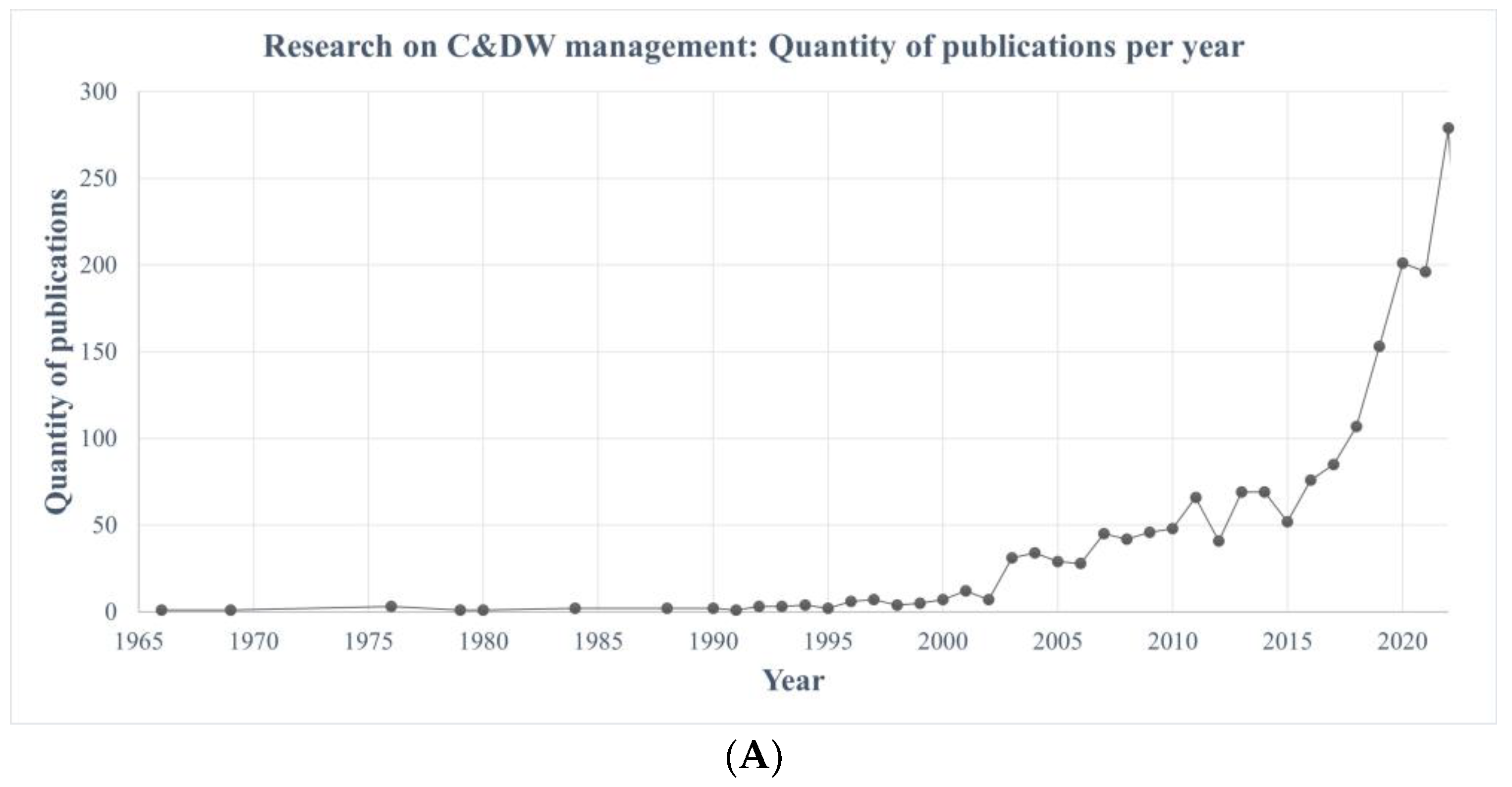
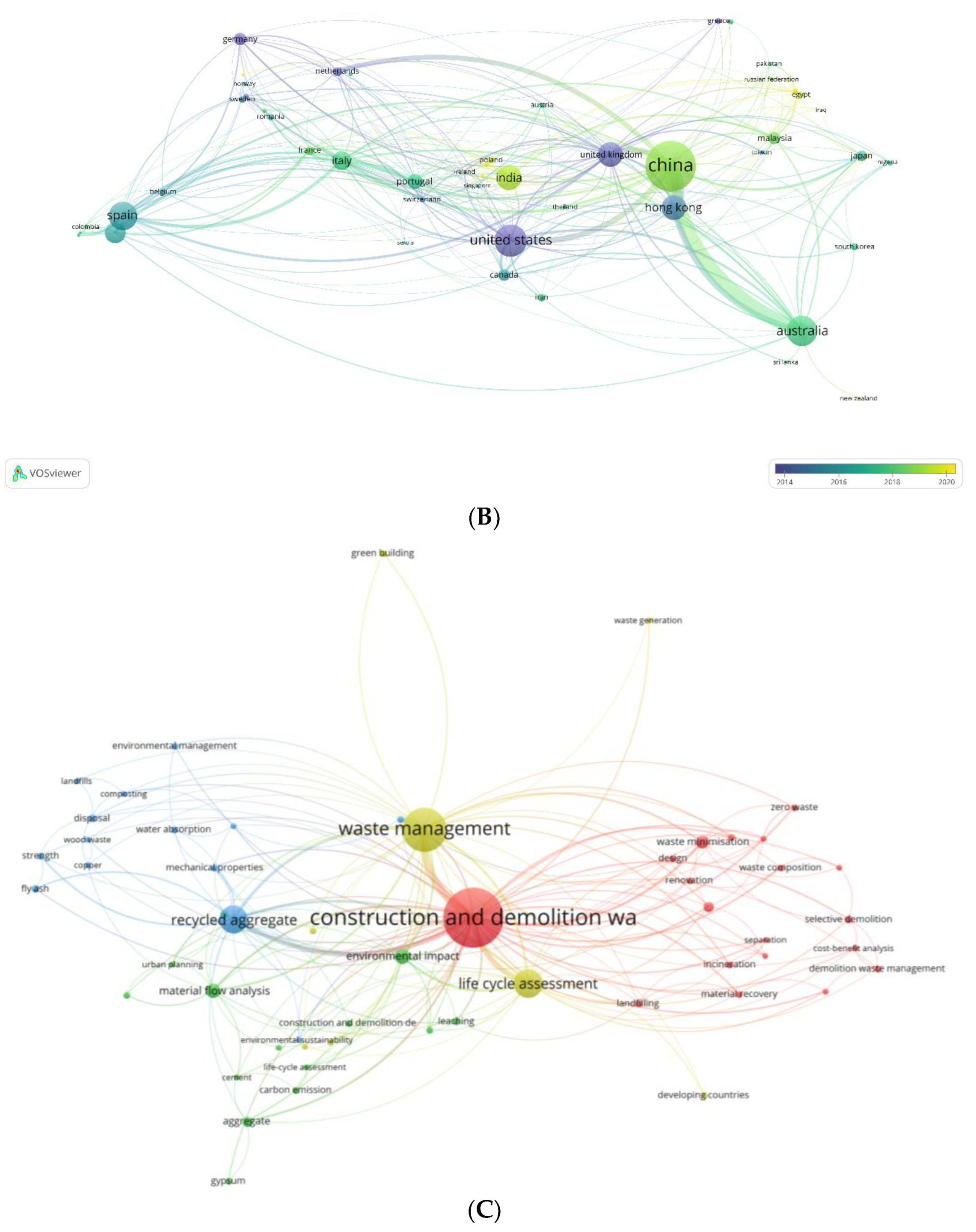

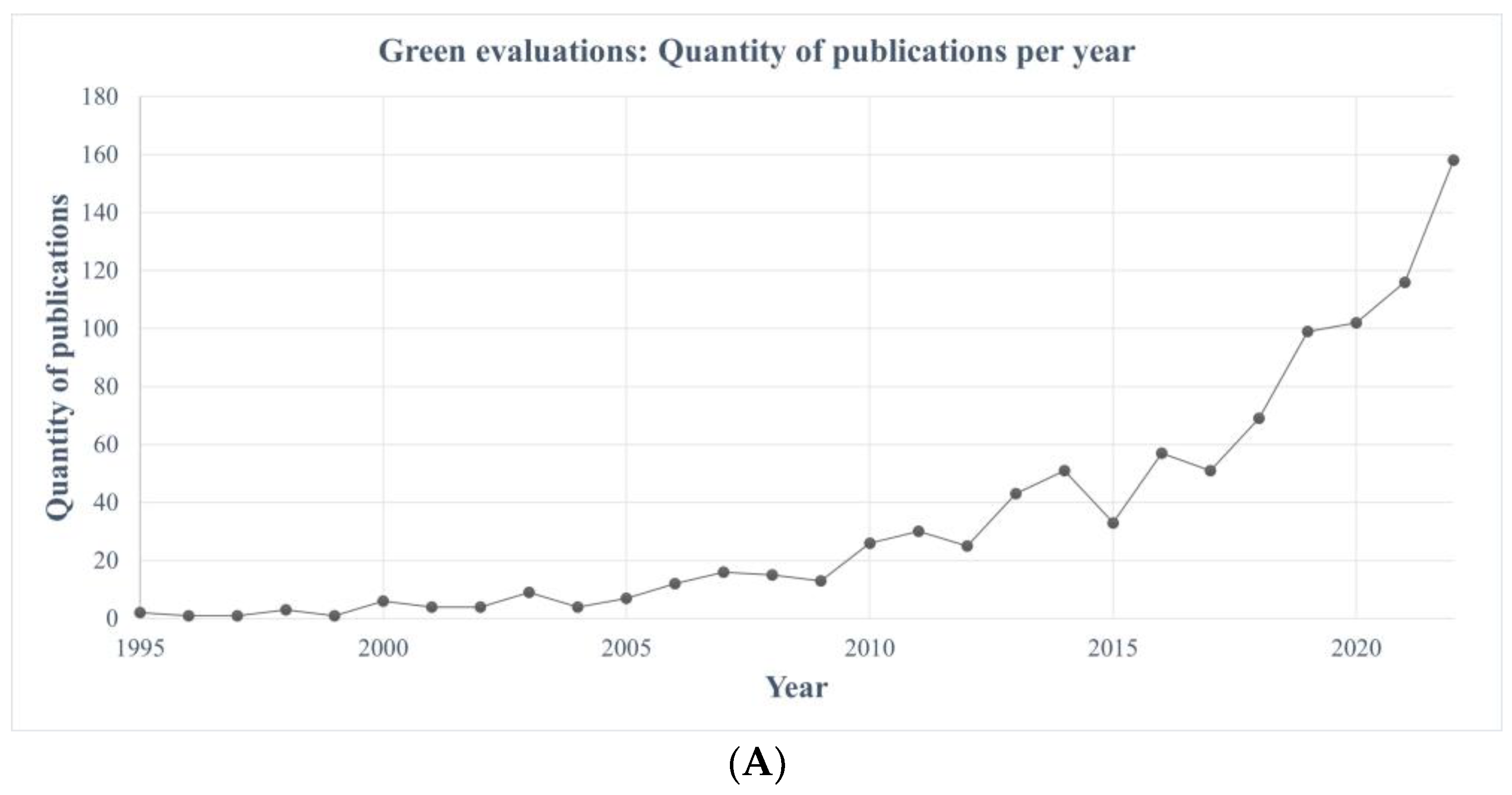
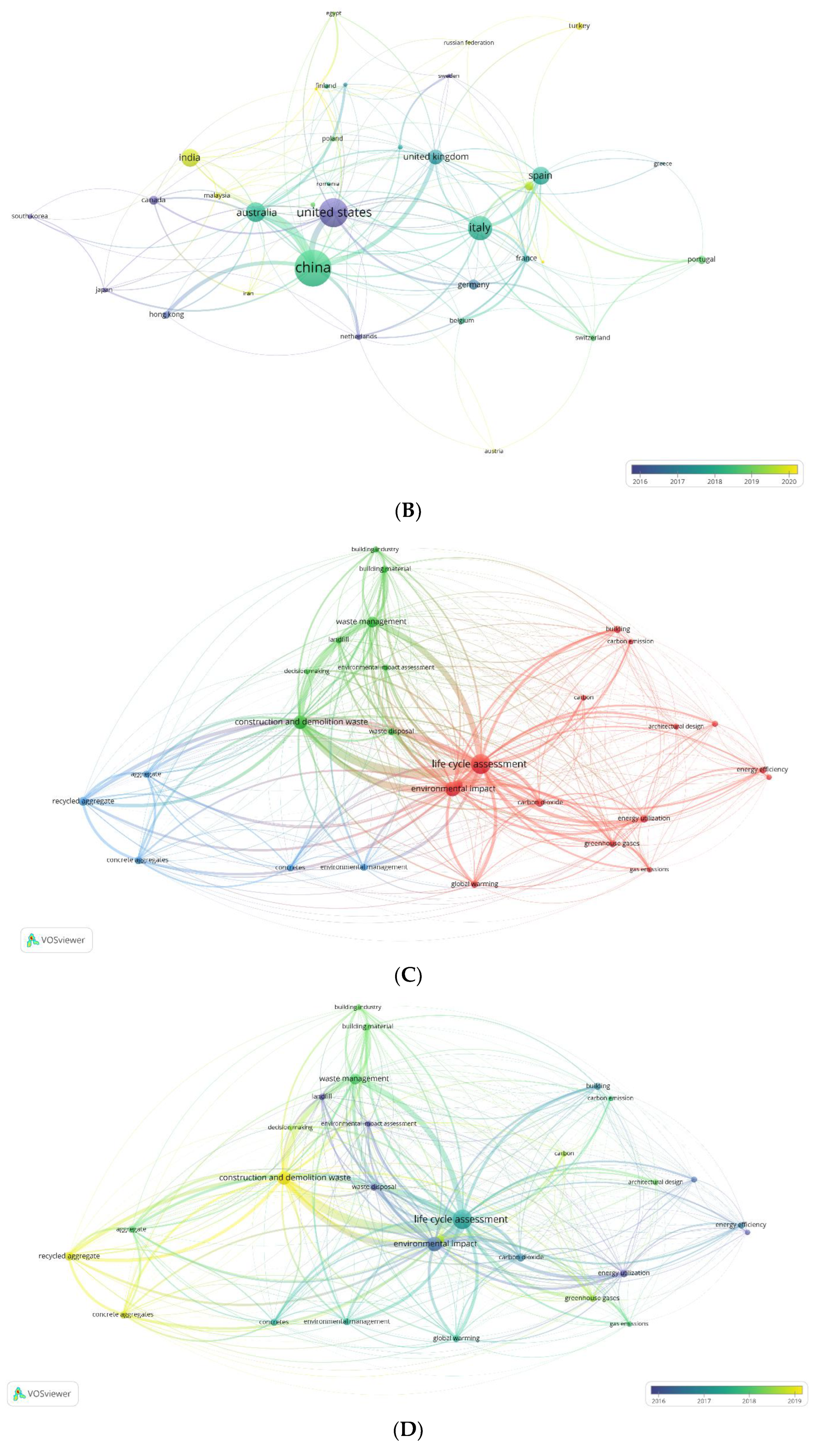
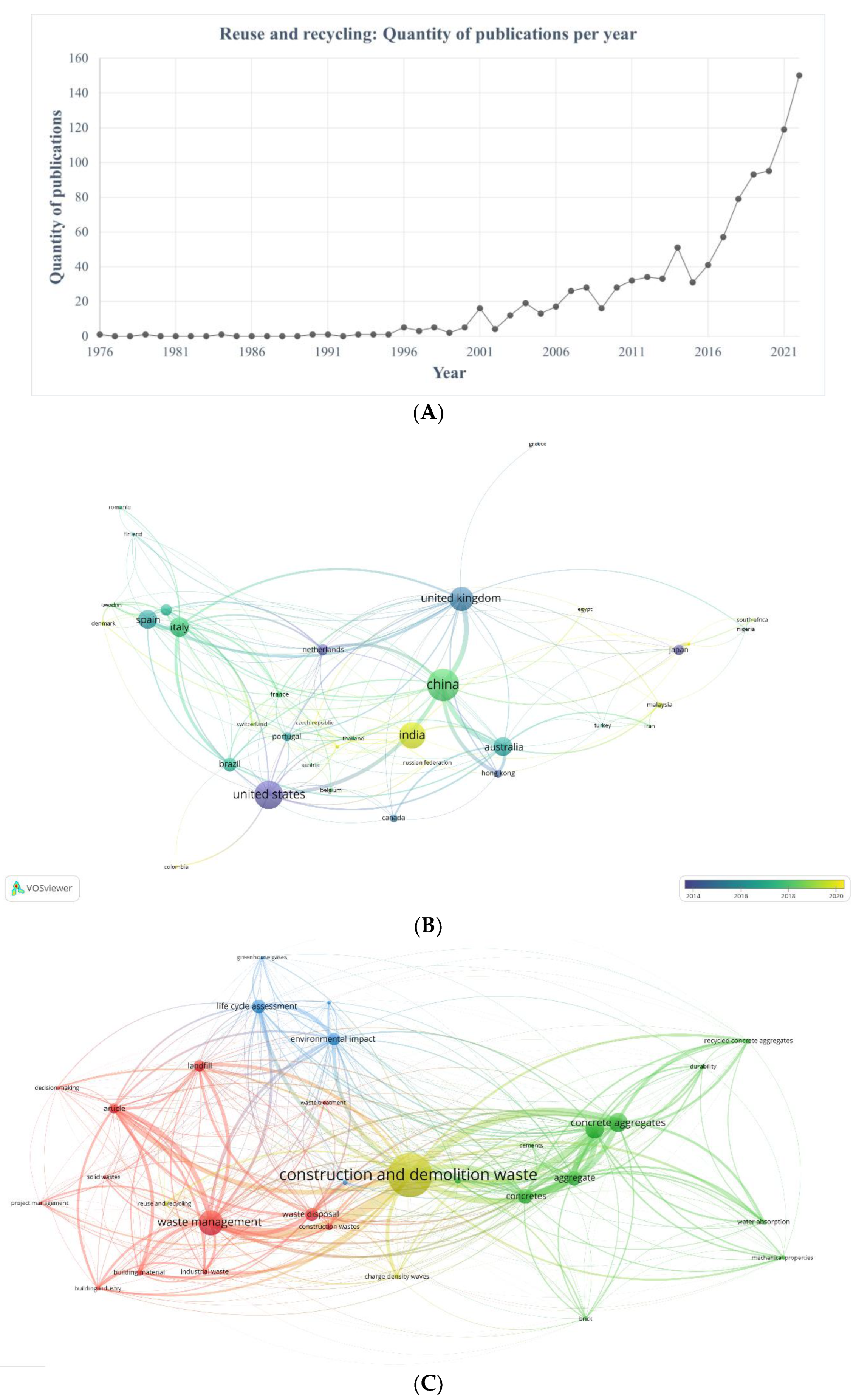
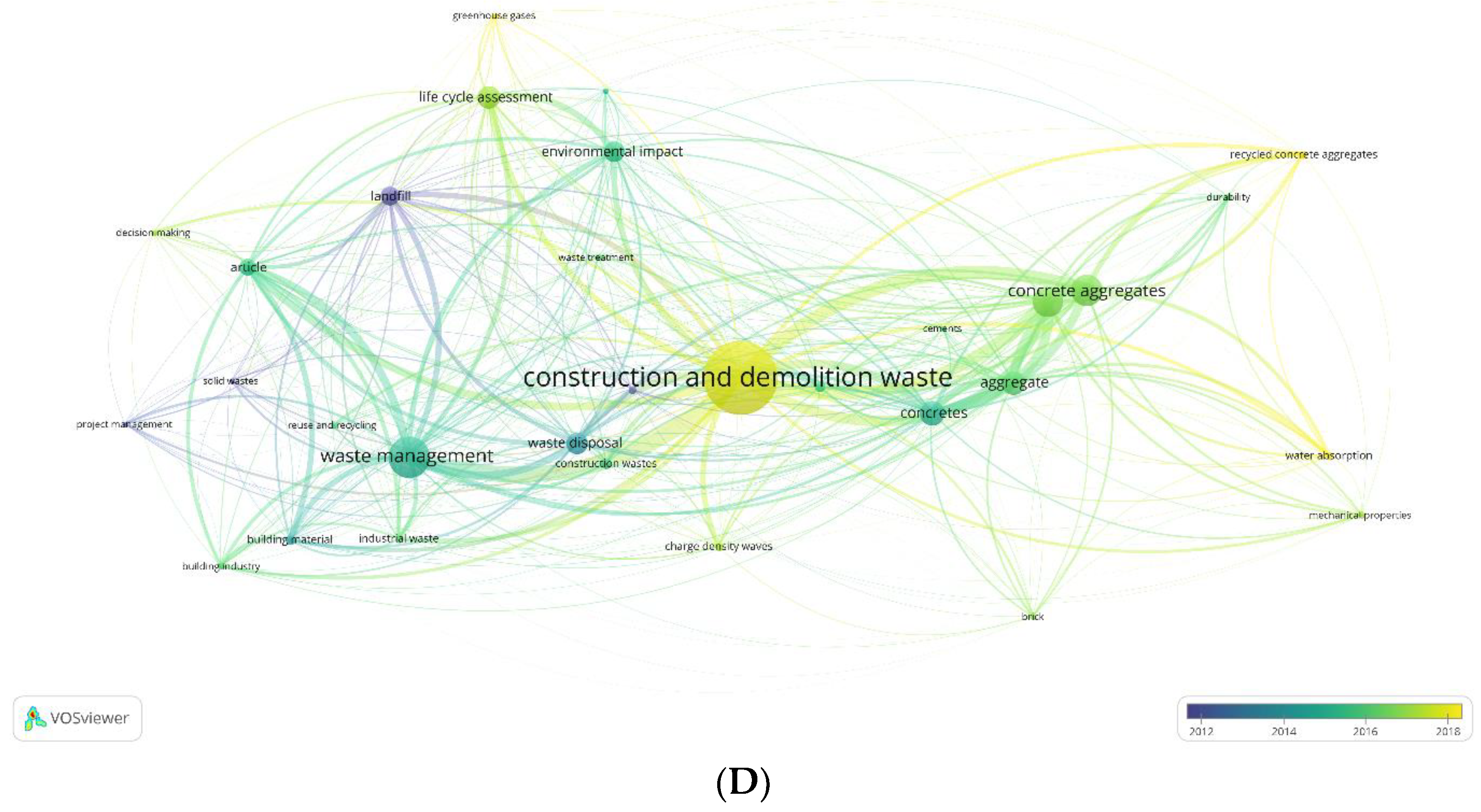
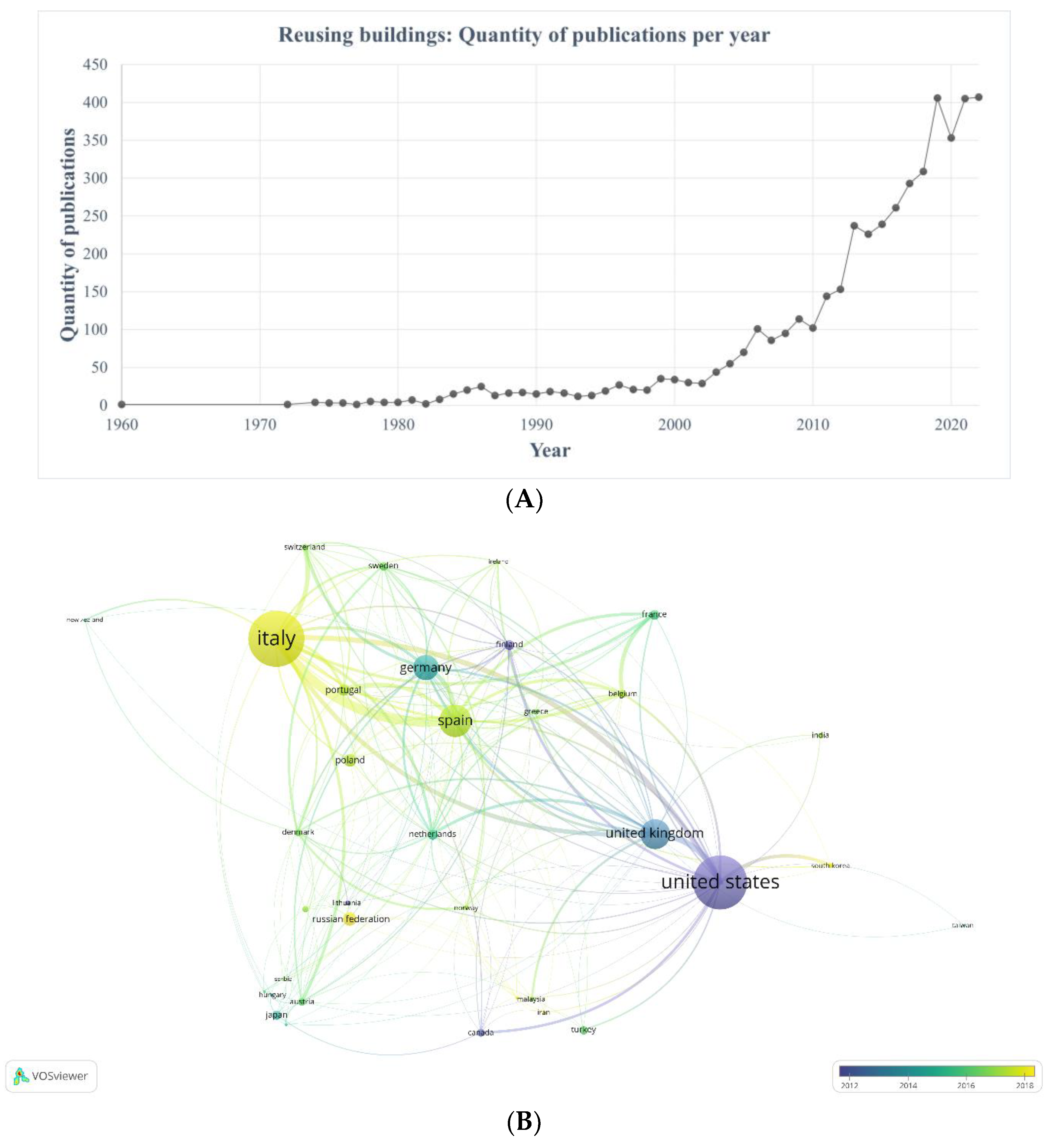
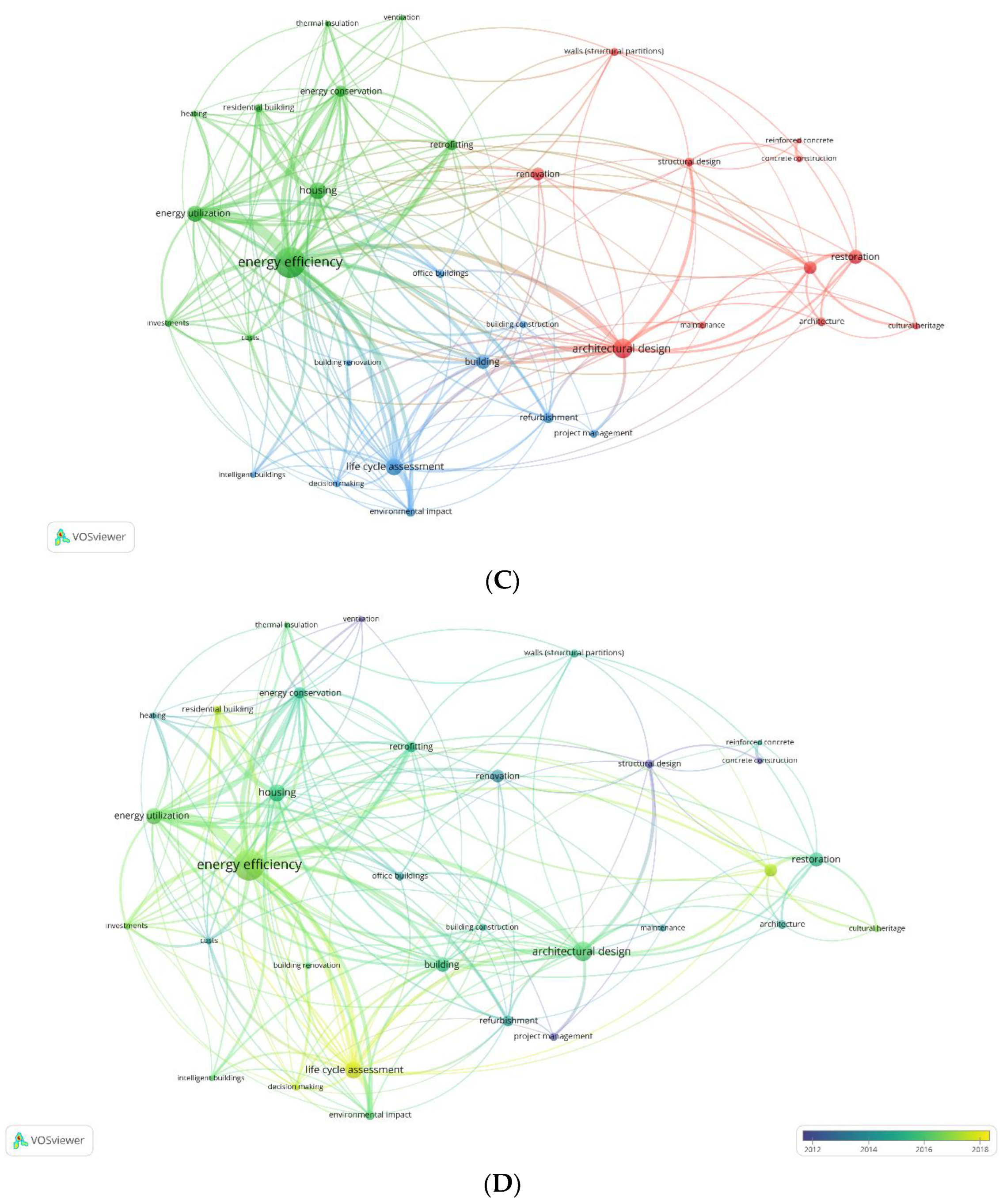
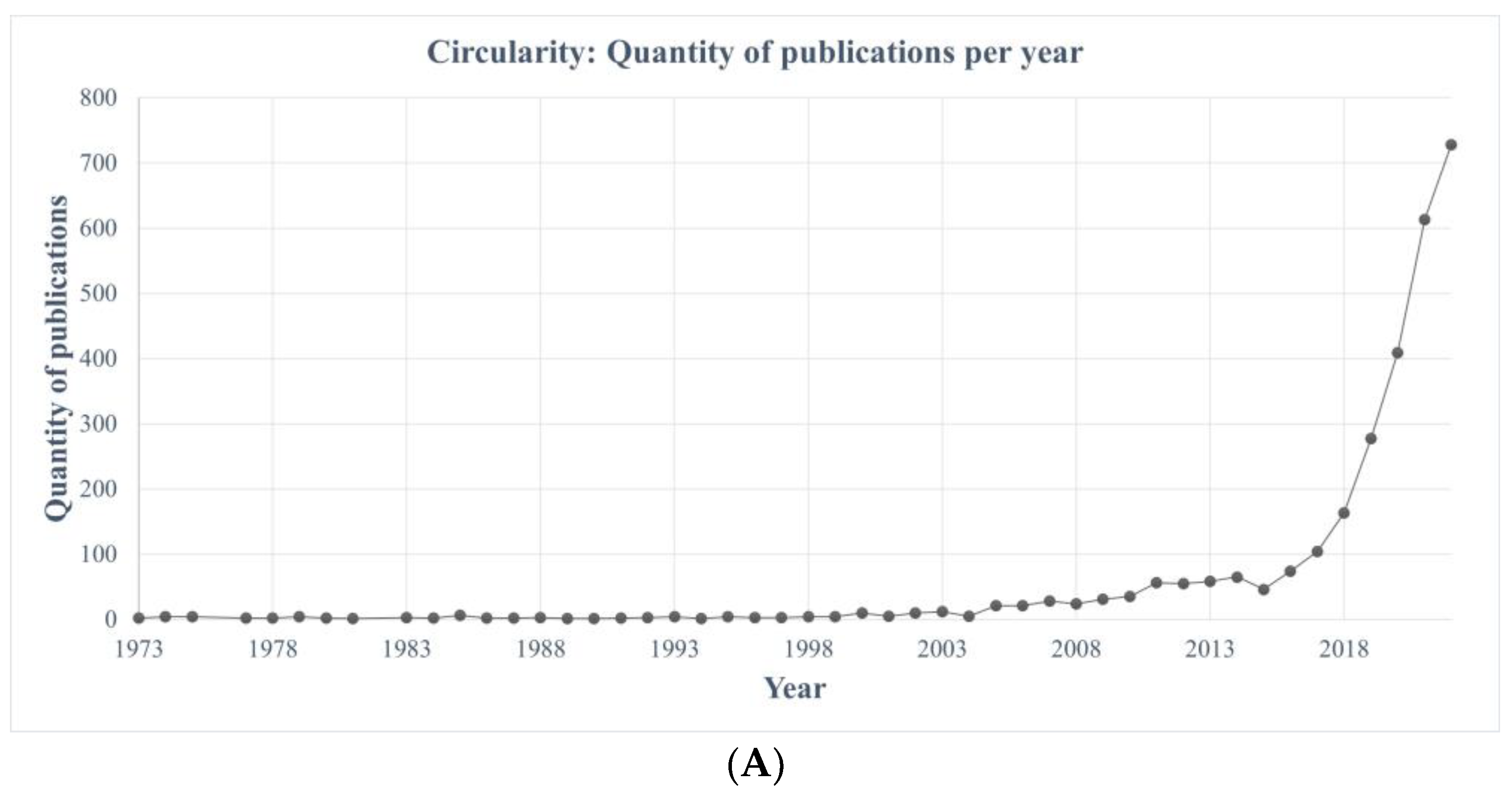

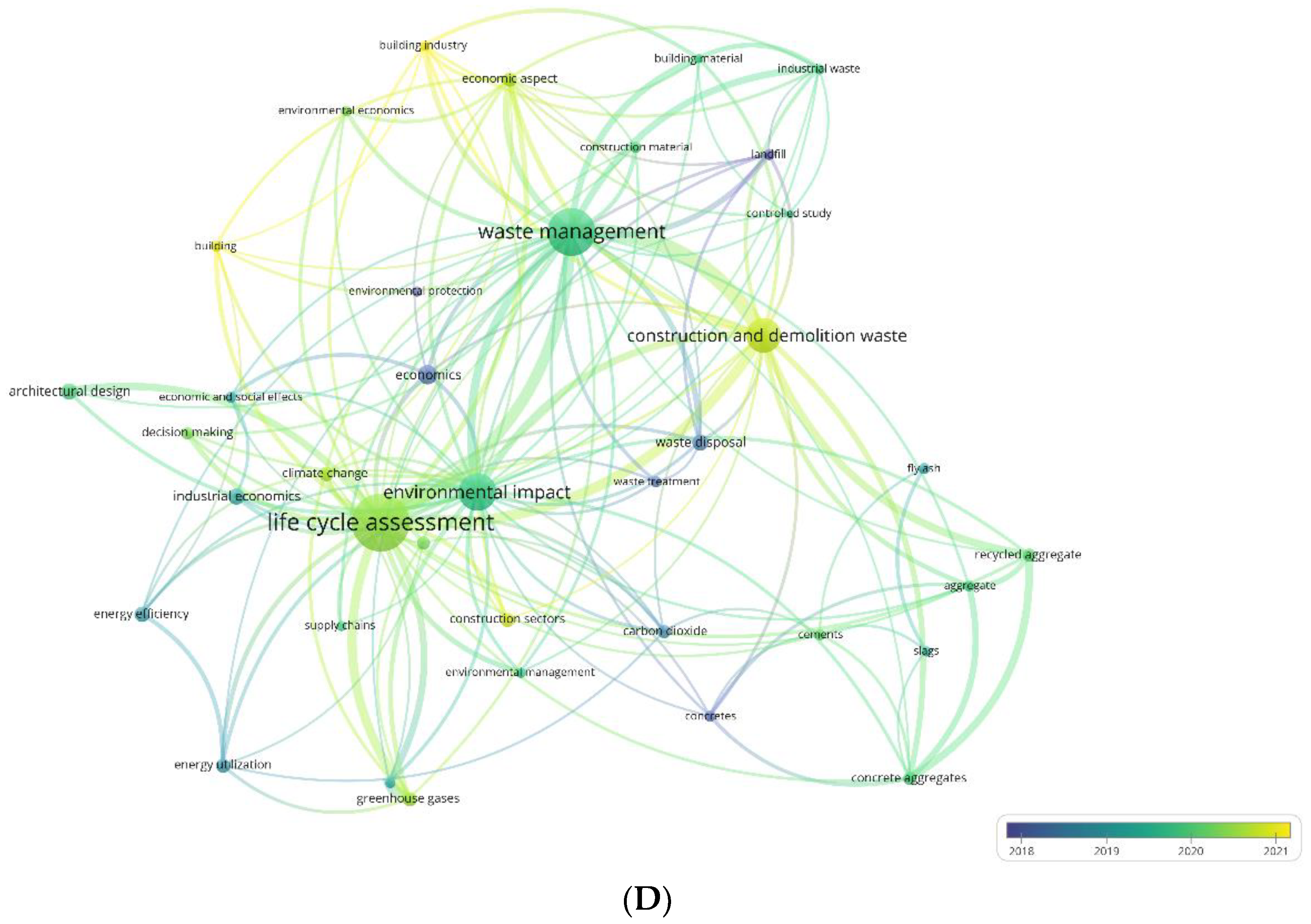
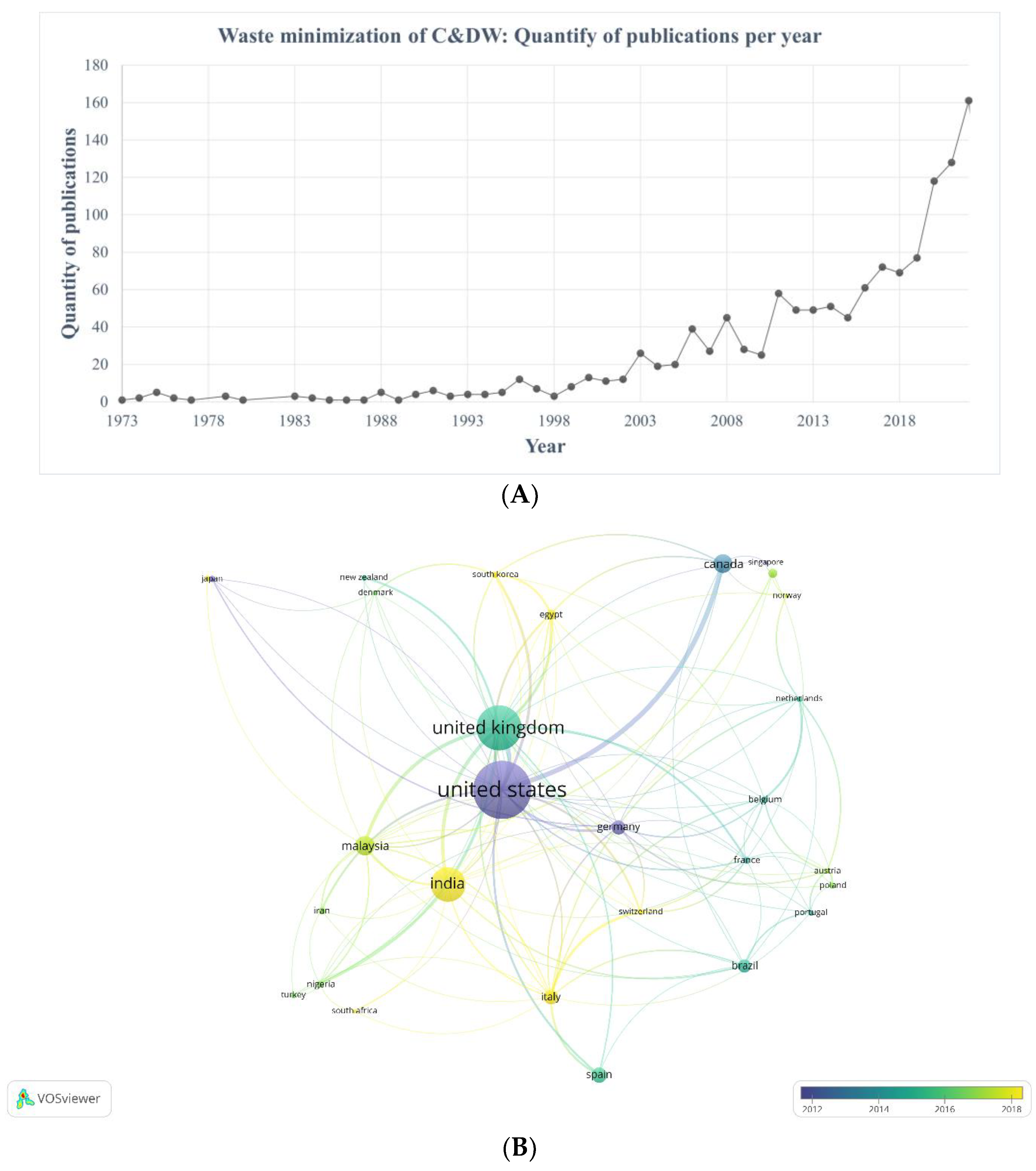
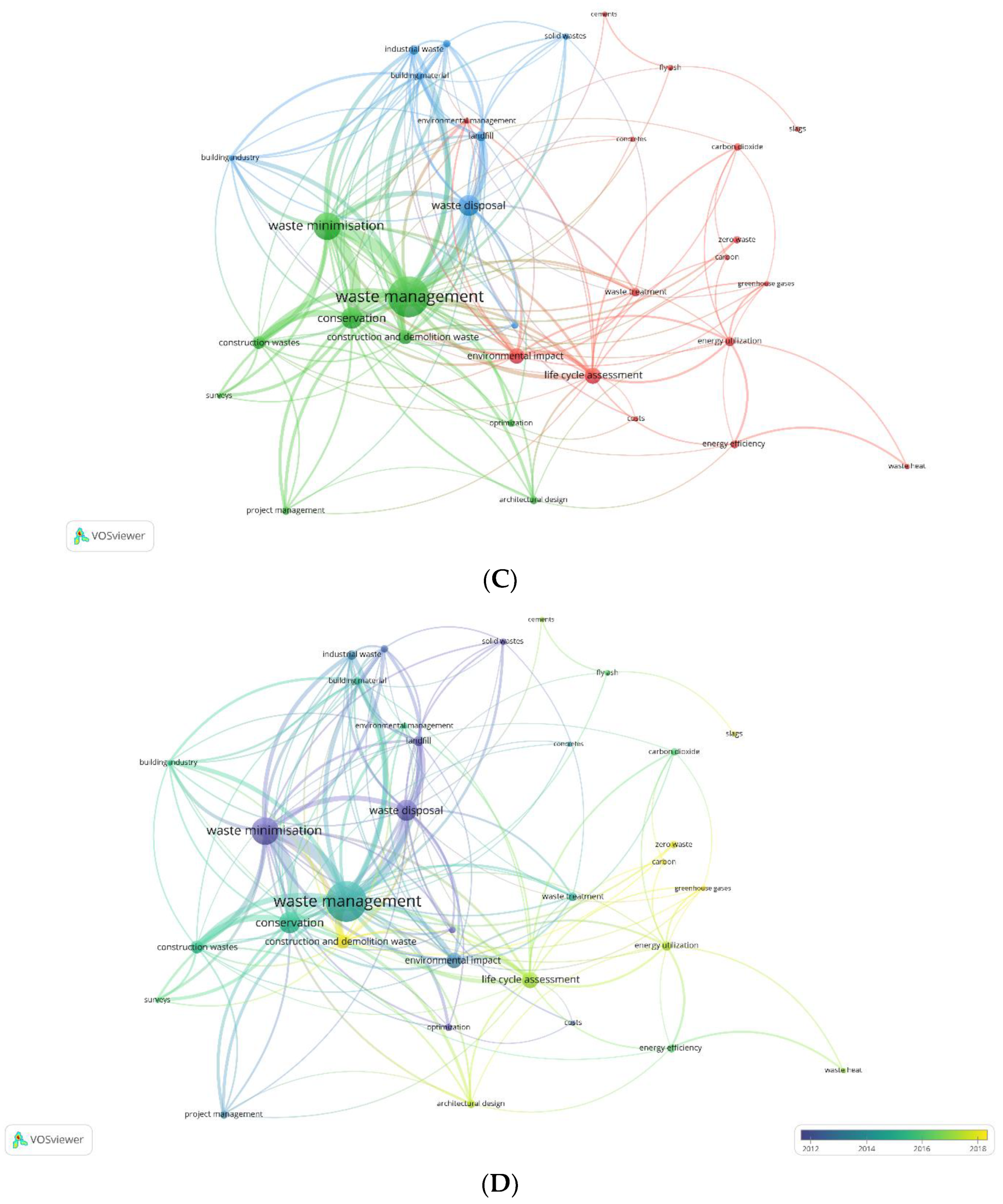
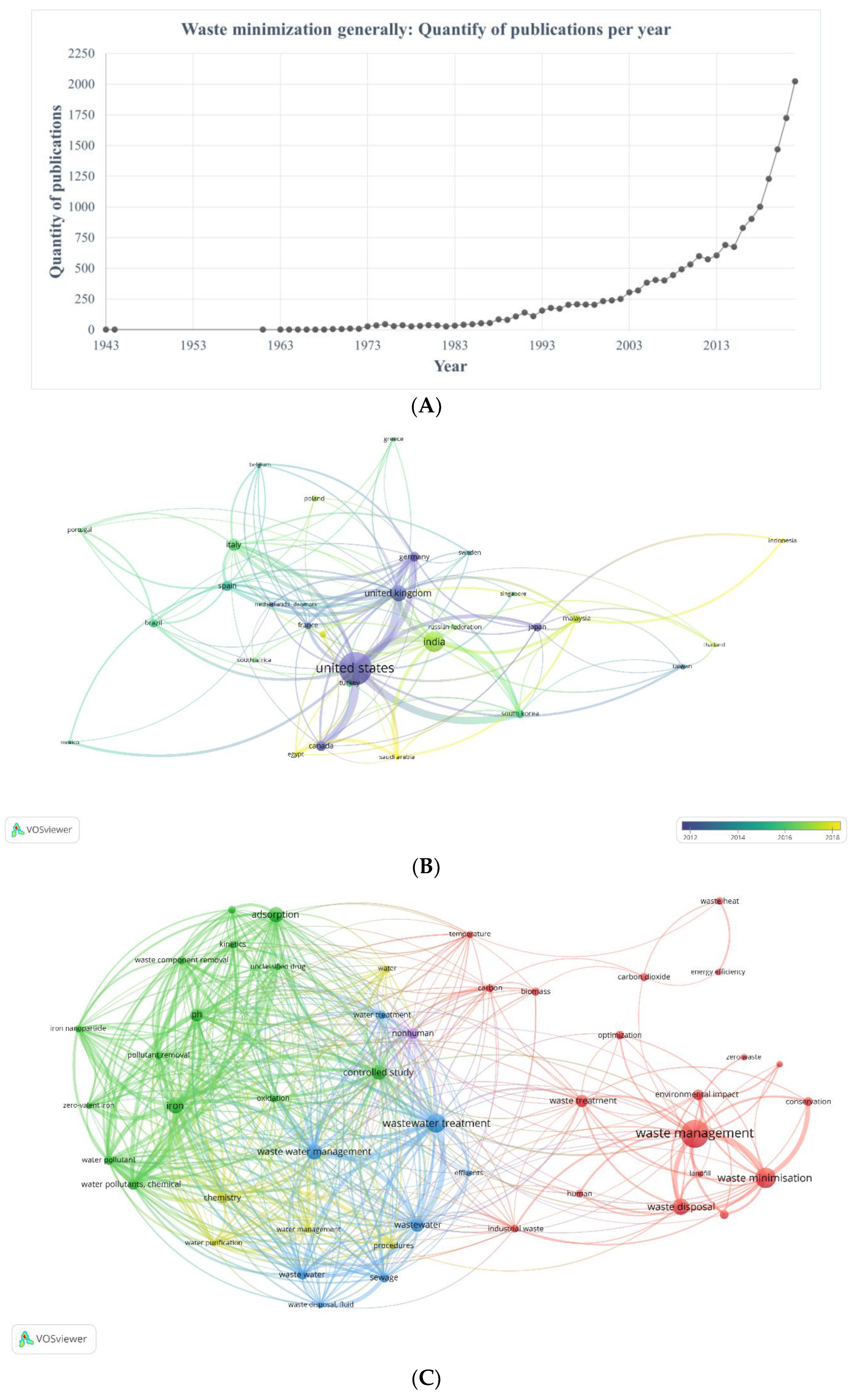
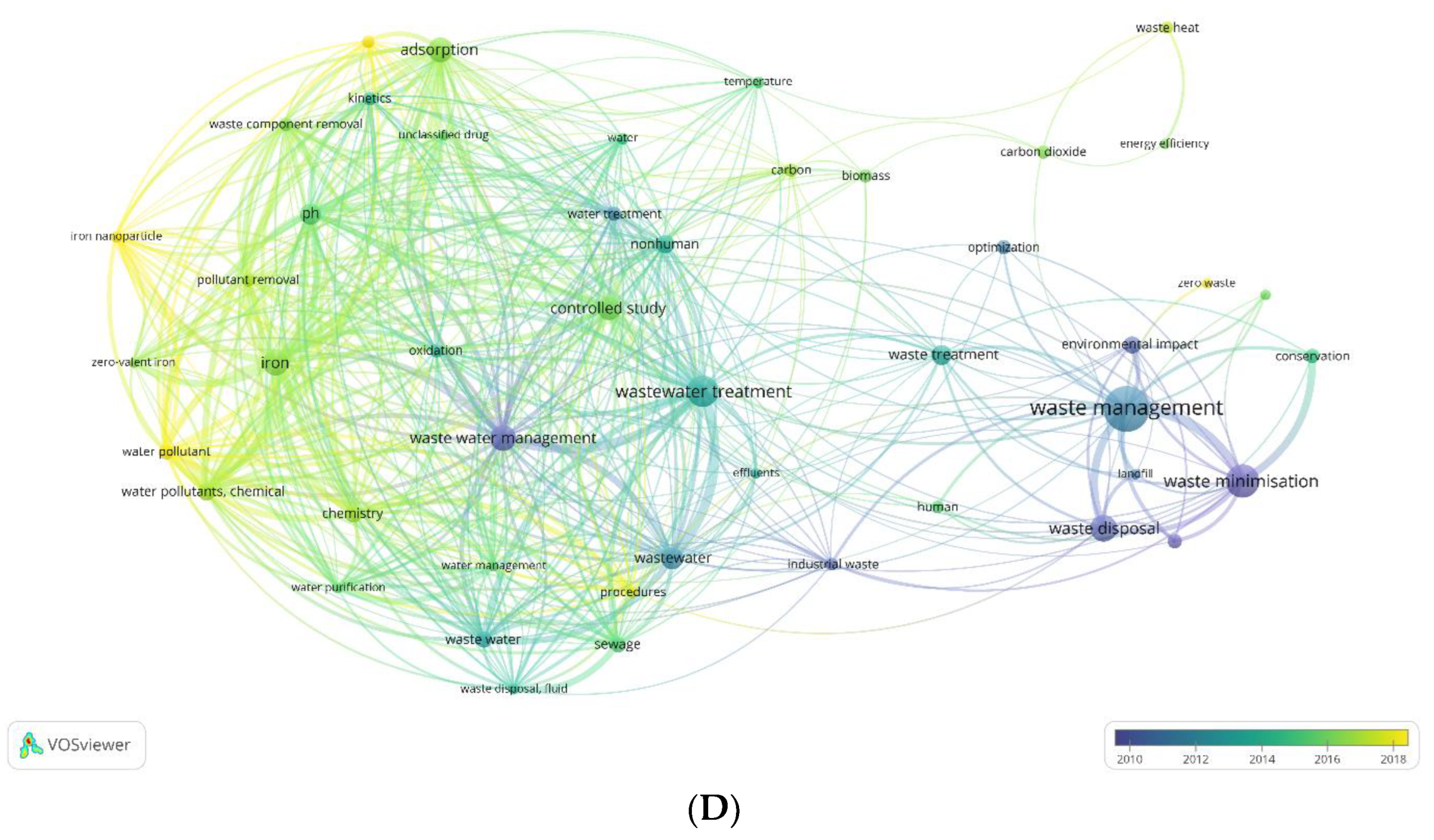
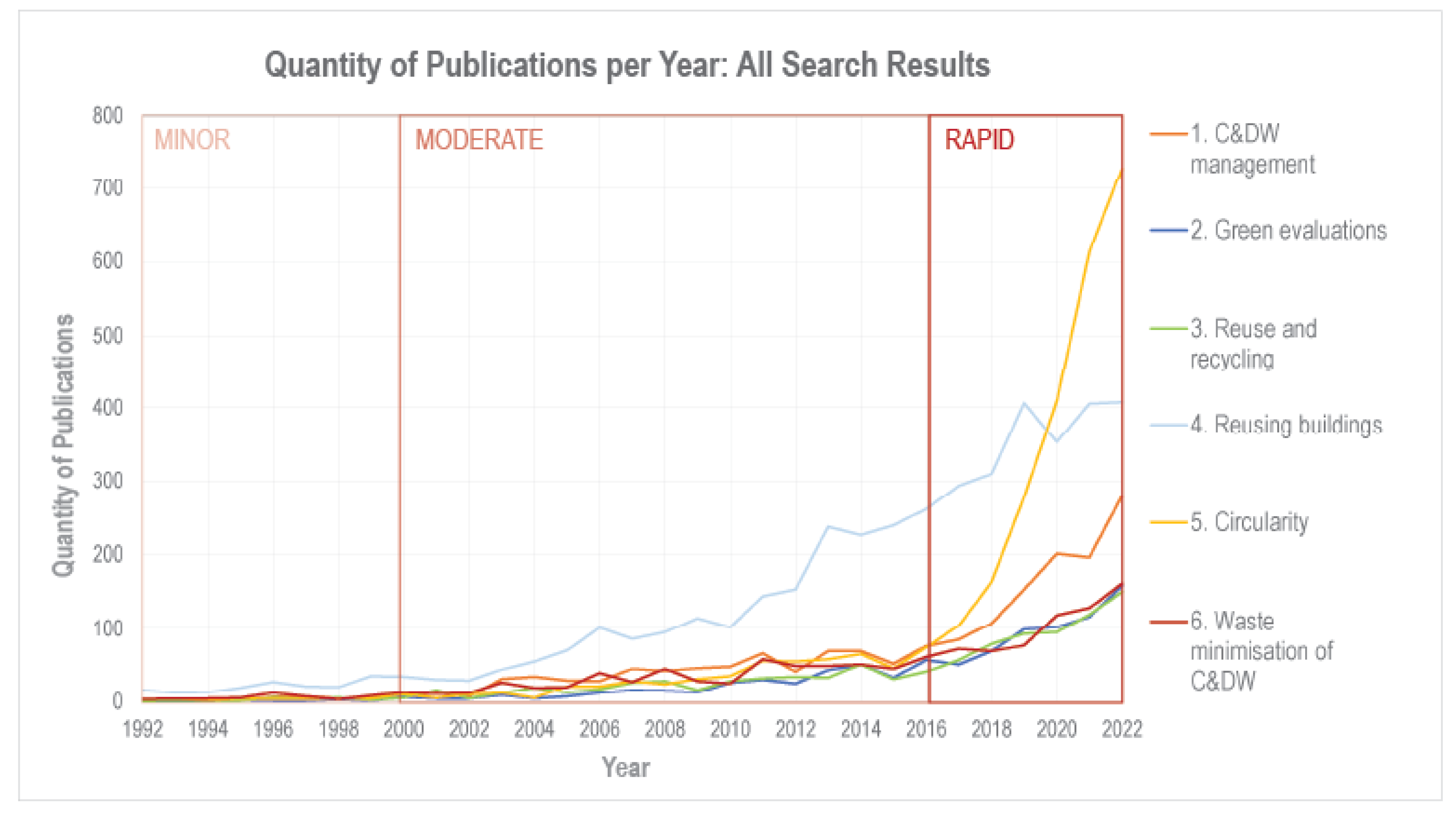
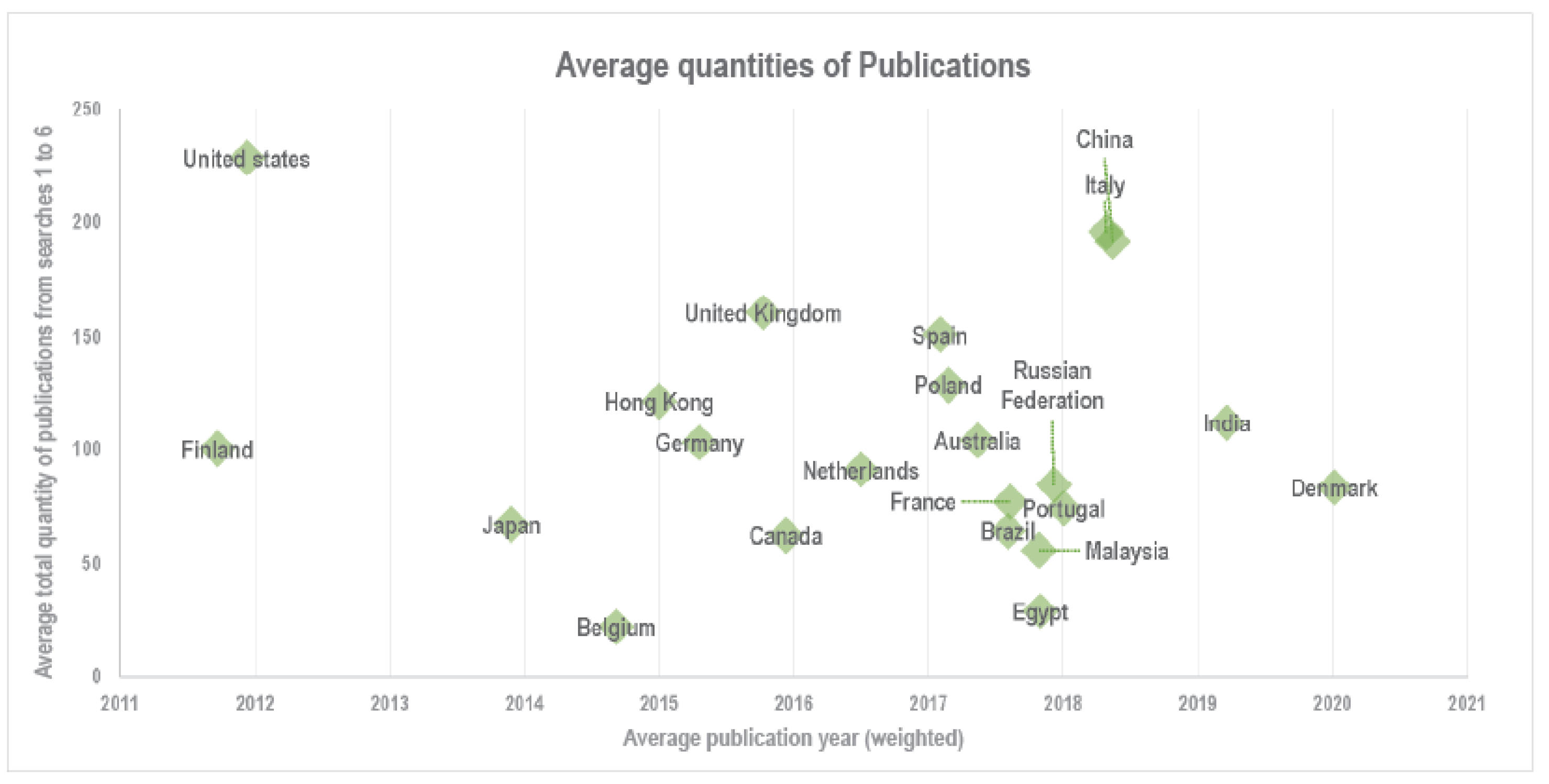
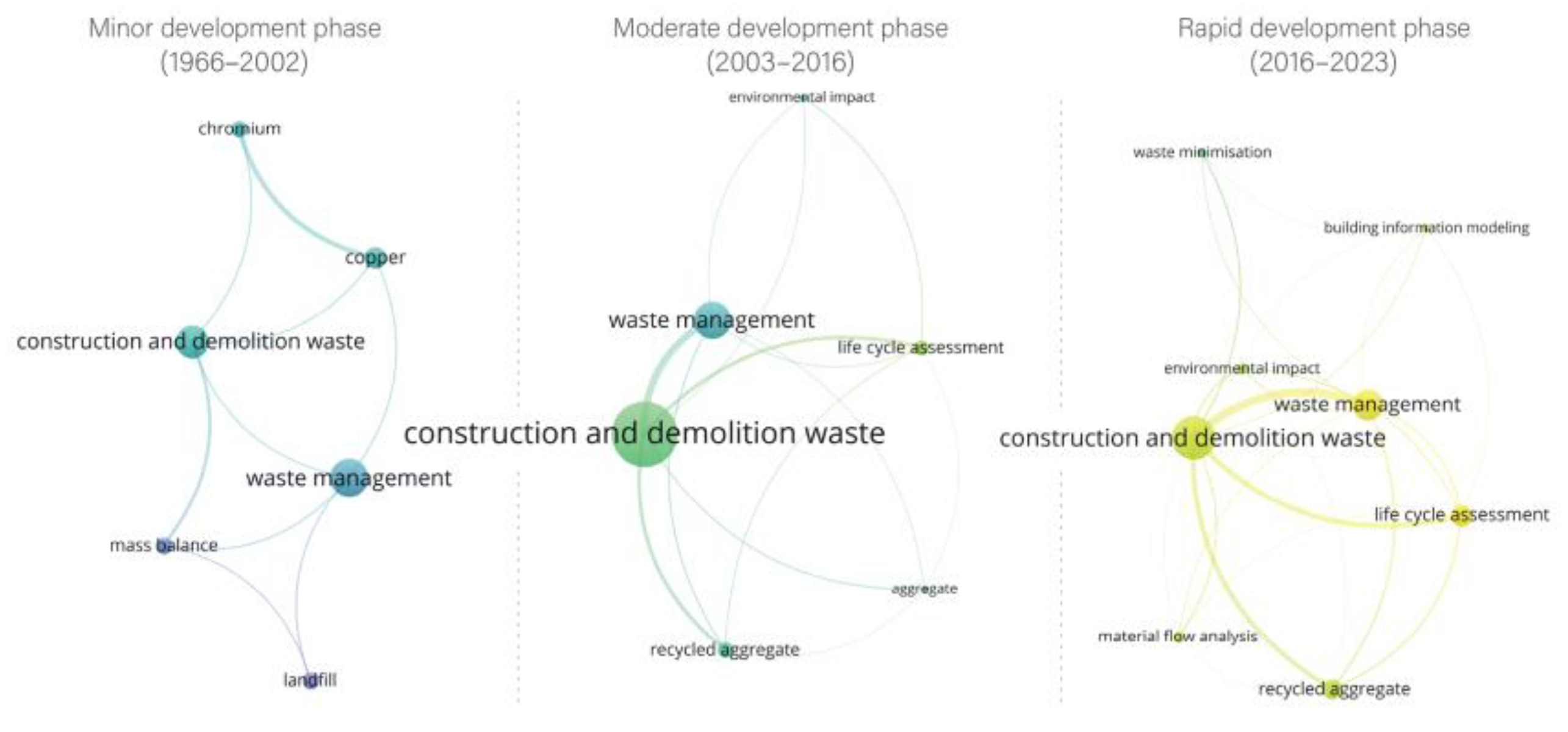
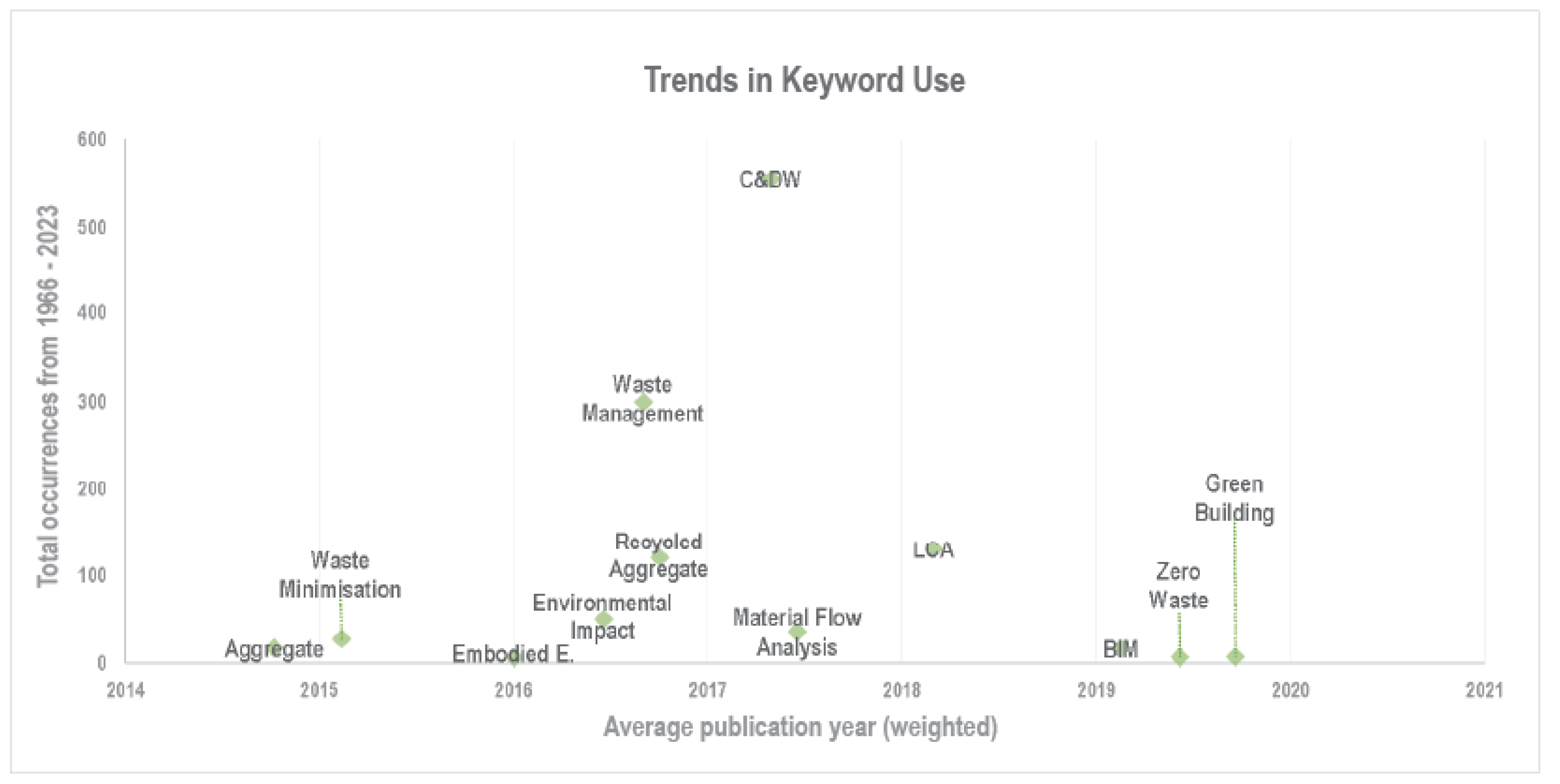
| Author | Date of Publication | Reported Increase in C&DW Publications | Reported Period of Minor to Moderate Development | Reported Period of Rapid Development |
|---|---|---|---|---|
| Wu et al. [18] | 2019 | 2400% increase from 1994 to 2017 | 1994–2013 | 2013–2017 |
| Jin et al. [14] | 2019 | 160% increase from 2009 to 2017 | 2009–2015 | 2015–2017 |
| Wang & Zhong [37] | 2022 | 2200% increase from 1998 to 2021 | 1998–2013 | 2013–2021 |
| Elshaboury et al. [35] | 2022 | 2300% increase from 2001 to 2021 | 2001–2015 | 2015–2021 |
| Li et al. [17] | 2022 | 800% increase from 2007 to 2020 | 2007–2015 | 2015–2020 |
| Viswalekshmi et al. [10] | 2023 | 1000% increase from 1990 to 2020 | Linear development throughout the period | |
| Author | Date of Publication | Number of Publications in Review | Searched Database | Reviewed Period |
|---|---|---|---|---|
| Choudhary & Rajput [38] | 2023 | 2584 | Web of Science | 2002–2021 |
| Soto-Paz et al. [39] | 2023 | 2014 | Web of Science, Scopus and Dimensions | 2010–2022 |
| Viswalekshmi et al. [10] | 2023 | 133 | Scopus | 1991–2020 |
| Ma et al. [40] | 2022 | 110 | Web of Science | |
| Shao et al. [41] | 2022 | 1090 | Web of Science | 2000–2021 |
| Elshaboury et al. [35] | 2022 | 895 | Scopus | 2001–2021 |
| Li et al. [17] | 2022 | 494 | Web of Science | 2007–2020 |
| Wang et al. [42] | 2023 | 3550 | Web of Science | 2002–2022 |
| Chen et al. [43] | 2021 | 112 | Web of Science | 2010–2019 |
| Wu et al. [18] | 2019 | 1027 | Web of Science | 1994–2017 |
| Jin et al. [14] | 2019 | 410 | Scopus | 2009–2018 |
| Liu et al. [44] | 2017 | 857 | SCI Expanded database | 2000–2016 |
| Ghafourian et al. [45] | 2016 | 109 | Web of Science | 1996–2010 |
| Search | Boolean Search Terms | Search Date | Publication Date Range | Publication Number | Total Number of Items Found * | Number of Items that Met Threshold | Threshold Occurrence |
|---|---|---|---|---|---|---|---|
| 1. | ‘Construction AND demolition AND waste AND management’. | 13 March 23 | 1966–2023 | 1821 | 107 countries | 55 countries | 5 |
| 3562 keywords | 56 keywords | 7 | |||||
| 2. | ‘Life Cycle assessment OR embodied energy OR carbon footprint OR green building OR living building challenge AND construction AND demolition’. | 6 April 23 | 1995–2023 | 1003 | 77 countries | 35 countries | 8 |
| 2192 keywords | 28 keywords | 10 | |||||
| 3. | ‘Reuse OR recycle OR reclaim OR (salvaged AND material) OR upcycle AND construction AND demolition’. | 29 May 23 | 1976–2023 | 1081 | 103 countries | 35 countries | 7 |
| 2416 keywords | 31 keywords | 6 | |||||
| 4. | ‘Refurbishment OR renovation OR (heritage AND restoration) AND building AND construction’. | 29 May 23 | 1960–2023 | 4665 | 223 countries | 36 countries | 28 |
| 9775 keywords | 32 keywords | 25 | |||||
| 5. | ‘Circular economy OR closing the loop OR zero waste OR narrowing the loop AND construction OR demolition’. | 29 May 23 | 1973–2023 | 3235 | 150 countries | 36 countries | 22 |
| 7548 keywords | 38 keywords | 14 | |||||
| 6. | ‘Waste minimization OR waste minimisation OR zero waste AND construction’. | 29 May 23 | 1973–2023 | 1356 | 120 countries | 29 countries | 13 |
| 3265 keywords | 33 keywords | 7 | |||||
| 7. | ‘Waste minimization OR waste minimisation OR zero waste’. | 29 May 23 | 1943–2024 | 19,693 | 461 countries | 30 countries | 150 |
| 34,953 keywords | 47 keywords | 60 |
Disclaimer/Publisher’s Note: The statements, opinions and data contained in all publications are solely those of the individual author(s) and contributor(s) and not of MDPI and/or the editor(s). MDPI and/or the editor(s) disclaim responsibility for any injury to people or property resulting from any ideas, methods, instructions or products referred to in the content. |
© 2024 by the authors. Licensee MDPI, Basel, Switzerland. This article is an open access article distributed under the terms and conditions of the Creative Commons Attribution (CC BY) license (https://creativecommons.org/licenses/by/4.0/).
Share and Cite
Petrović, E.K.; Thomas, C.A. Global Patterns in Construction and Demolition Waste (C&DW) Research: A Bibliometric Analysis Using VOSviewer. Sustainability 2024, 16, 1561. https://doi.org/10.3390/su16041561
Petrović EK, Thomas CA. Global Patterns in Construction and Demolition Waste (C&DW) Research: A Bibliometric Analysis Using VOSviewer. Sustainability. 2024; 16(4):1561. https://doi.org/10.3390/su16041561
Chicago/Turabian StylePetrović, Emina Kristina, and Caroline Ann Thomas. 2024. "Global Patterns in Construction and Demolition Waste (C&DW) Research: A Bibliometric Analysis Using VOSviewer" Sustainability 16, no. 4: 1561. https://doi.org/10.3390/su16041561
APA StylePetrović, E. K., & Thomas, C. A. (2024). Global Patterns in Construction and Demolition Waste (C&DW) Research: A Bibliometric Analysis Using VOSviewer. Sustainability, 16(4), 1561. https://doi.org/10.3390/su16041561






